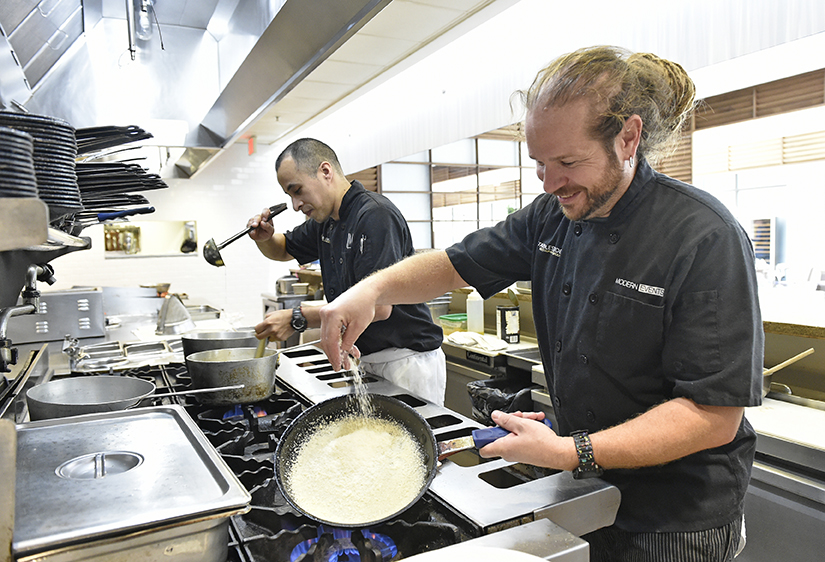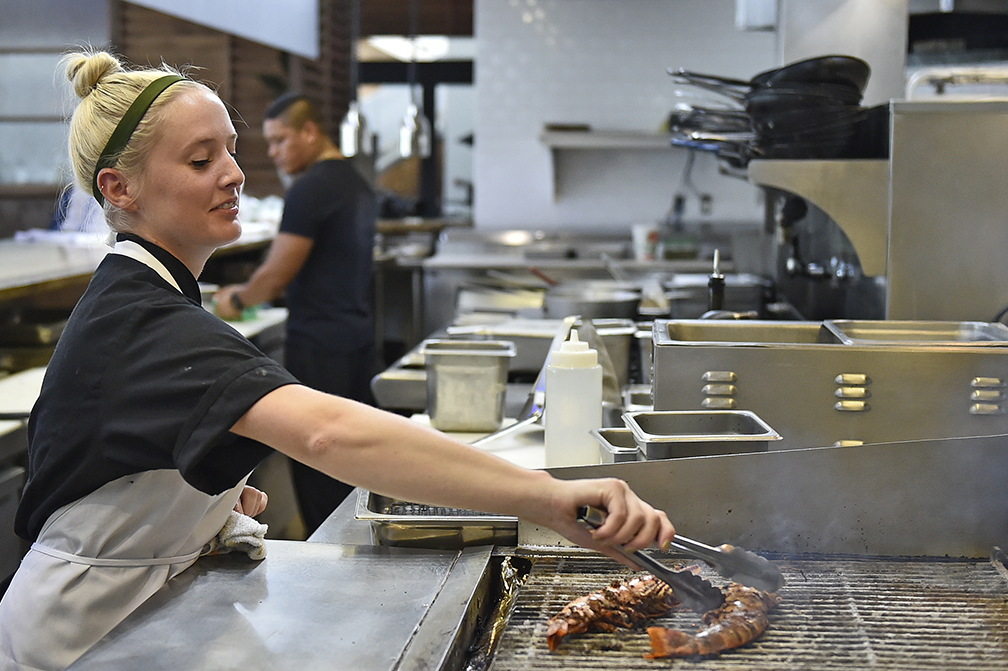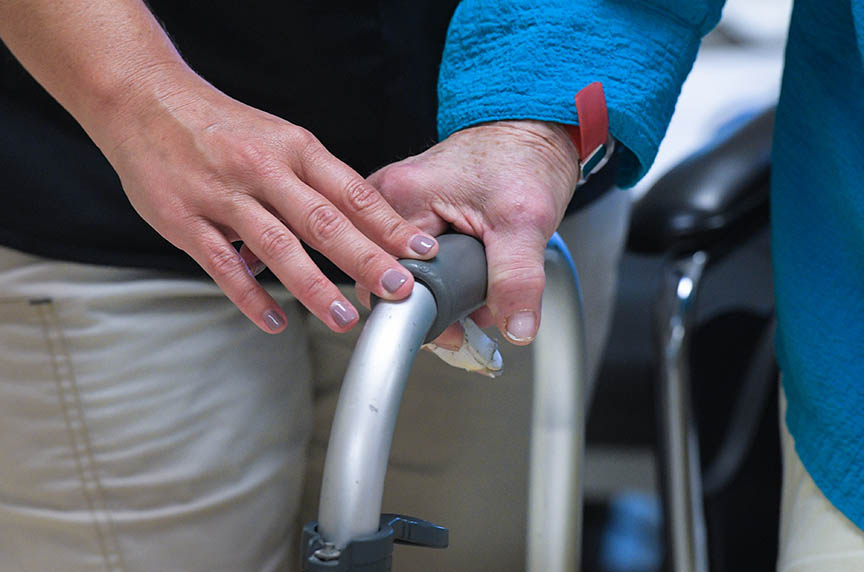
The wage imbalance
How Sarasota County’s fortunes are changing, and why that matters to all of us
By Barbara Peters Smith
barbara.smith@heraldtribune.com
Sarasota County: Where do you fit in?
When you’re surrounded in your home or workplace by others who share your own demographic profile, it can be challenging to understand your place in the community as a whole. Here’s an interactive quiz designed to give you a sense of the bigger picture.
From the hands that prepare and plate an order of the Local Cobia Barbacoa at Louies Modern, an upscale restaurant in downtown Sarasota ... to the ones that carry the dish from kitchen to dining room ...
to the ones that pick up a fork to spear the first bite ...
to the ones that rinse away those last smears of chimichurri sauce and make the china gleam for another customer —
an intimate exchange unfolds nightly that illustrates the subtle interconnections among Sarasota County residents of various ages, incomes and origins.
When dinner is over and the lights dim in this and other restaurants throughout the county, chefs, servers, patrons and dishwashers head home to vastly different lives and challenges and joys. But those linkages among them silently persist.

(Herald-Tribune staff photo / Thomas Bender)
During the Great Recession, which hit this region early and hard in 2007 and lingered well past its official termination date of June 2009 — in the form of foreclosures, joblessness and stalled construction projects — the county’s economic interdependence was obvious. Now its effects are almost invisible for some, but painfully pressing for many.
While local residents in the top 40 percent income bracket have recovered nicely from the recession, most in the bottom 60 percent have not — and cannot.
In many ways, Sarasota County’s broadening income gap mirrors the nation’s, a chasm growing stubbornly wider since the late 1970s. The contrast remained hidden for decades, mostly for two reasons. First, while the rich got richer, the poor did not discernibly grow poorer: U.S. poverty hasn’t really increased in the last 40 years; the bottom 5 percent of households are pretty much stuck where they were back then.
Meanwhile, the dramatic enrichment of the wealthiest households — in tandem with the lowering of maximum income tax rates — has been hard for most people to detect or even imagine: Traditional measures of annual household income cut off at $200,000 and above, and don’t begin to capture the outsized loads of bacon that a tiny slice of Americans bring home each year. For those in the top 1 percent, that was an average of $1.7 million in 2013, according to a respected analysis by New York University economist Edward Wolff.
But this nationwide disparity is sharpened in Sarasota County by a unique interplay of demographic patterns that could signal trouble ahead — unless local attempts at course correction succeed in defying current statistical projections.
In this series, the Herald-Tribune spotlights three challenges that are especially steep in the place we call home:
• The wage imbalance: A high percentage of this county’s personal income comes not from jobs, but in the form of investments, pensions and benefits accrued in lifetimes spent elsewhere. Wage earners receive an average $895 per week, less than 84 percent of the U.S. average, $1,070. This region’s occupations adding the most employees — retail, health assistance, customer service, food preparation and landscaping — do not pay enough to cover rent on a one-bedroom apartment, according to figures compiled by Sarasota County demographer Tamara Schells.
A recent Bureau of Labor Statistics report did indicate an overall 7 percent wage increase for Sarasota County from the first quarter of 2016 to the same period this year, which was hailed as good news. But the local service sector showed no corresponding improvement. More reliable annual data — smoothing out the effects of quarterly fluctuations — will not be available until June.
The presence of Sarasota County residents who live at the peak of personal wealth is more difficult to calculate, aside from the rough measure of multimillion-dollar residential sales. But one intriguing indicator of the comings and goings of our richest citizens is the volume of private jet fuel pumped at Sarasota-Bradenton International Airport: 2.84 million gallons at the height of the last real estate boom in 2007, sliding to 2.44 million during the recession, and rebounding to 2.96 million in the airport’s last fiscal year.
• The age imbalance: About 41.9 percent of Sarasota County residents are 60 and older, compared with 25.7 percent in the state as a whole, according to the latest figures from the Florida Department of Elder Affairs. As the population swells from an estimated 412,589 now to 478,113 in 2040, that share of older residents is projected to climb to 45.3 percent. This trend is not dire in itself — but it also means a continued shrinking of the county’s share of residents in their prime working years. In short, we have a scarcity of millennials. So the portion of our population most in need of services and support — from prepared meals to physical therapy — may discover that these are difficult to come by. Meanwhile, there’s a shortage of the young, college-educated professionals whose presence is now vital to an expanding local economy.
• The housing imbalance: Every new gated community built in the county creates a need for places where landscapers, housekeepers and pool cleaners can live. That means long and inefficient commutes for workers who are just one car breakdown away from financial disaster. Meanwhile, the county is full of empty bedrooms in single-family homes: Three-quarters of all households here are composed of one or two residents, says Allen Parsons — Sarasota County’s planning manager, soon to become planning director for Longboat Key. And a high percentage of housing units belong to nonresidents — 17 percent in 2015, compared to 4.1 percent in the nation as a whole.
Each of these demographic patterns would, in itself, pose a challenge for any American community as the nation ages and its economic system evolves. But for Sarasota County, the combination creates a special urgency that will require the focused attention of anyone who cares about maintaining or enhancing the quality of life here.
This demands a willingness to consider a departure from business as usual, said Jon Thaxton, a longtime county commissioner and now senior vice president for community investment at the Gulf Coast Community Foundation. At the foundation’s Sarasota office, he often looks out at Osprey Avenue and notices the number of delivery and maintenance workers who pass.
“Every one of us, every day, takes for granted this service workforce,” he says. “We need to be thinking, ‘OK, if I’m going to approve another 1,000 market-rate homes that will require another 50 workforce units to service them, what will be the economic and social impacts? One way or another we will pay. If we start looking at it like a business decision, a balance sheet equation, we will start second-guessing ourselves and say, ‘We need to find another way.'”
The wage imbalance
A primary factor suppressing wages in Sarasota County is a dramatically escalating local reliance on service workers, who hold about 52 percent of all the jobs here. As the population grows, that proportion swells: Each year, the 15 percent of newcomers with incomes over $75,000 act as an economic magnet for the 45 percent of newcomers who make less than $25,000 waxing BMWs and serving lattes. As a result, the share of income from wages in this county is shrinking faster than the state and national average.
When you view Sarasota County’s economic recovery from the recession in terms of individual personal income, the rebound can be illustrated in a U-curve with a happy lift on its right side: from $50,904 in 2006 to a low of $45,450 in 2009, rising to $56,426 in 2015. Much of that gain derives from investments and retirement benefits, which account for 62 percent of total personal income here — compared to 36 percent in the nation as a whole.
A corresponding raise simply hasn’t happened for many county residents who work for a living. The number of wage-paying jobs fell during the recession and did not spring back up as robustly: from 175,108 in 2006 down to 142,985 in 2010, rising only to 171,149 in 2015. And the earnings those positions command remain, with a few exceptions, stuck in neutral.
This is partly because we are still feeling the recession’s aftershocks, says Mireya C. Eavey, Sarasota area president for United Way Suncoast.
“For five years there were really no opportunities at all,” she recalls, and employers sliced extras like on-the-job training out of their budgets. “Then they started hiring people, but the wages were stagnant because we had people who were desperate; they needed to get back into the workplace.”
Eavey says that a mismatch between worker training and workforce opportunities — which began in the downturn because of confusion over which jobs might be coming back — is still not being adequately addressed.
“There’s this skill gap,” she notes. “Now there are a lot of job openings. We have many very skilled individuals that went back to school and got certifications. They’re probably getting jobs, but not at the level of pay that they should be for the level of schooling or certifications.”
Beyond the service economy, office or professional positions in Sarasota County also pay less on average than comparable jobs elsewhere. This phenomenon has long been known as the “Sunshine Tax” — an acknowledgement that more qualified candidates will compete to work in a pleasant climate, especially when some of the pay cut is offset by Florida’s lack of a state income tax.
But Teri Hansen, CEO of the Charles & Margery Barancik Foundation, believes the situation is being worsened by a flood of baby boomers who relocate to Sarasota County and want to keep working past their retirement age. This, again, is a cultural shift being observed nationwide. But our county is far ahead of the curve, with 10 percent of residents over 65 still working — twice the national average.
“An unfortunate trend is that people who had big jobs elsewhere, and made enough, want to spend the rest of the their lives here,” Hansen says. “But they might want a little extra income, so they will take jobs for next to nothing. I think it hurts the overall trend of salaries. And it hurts the people trying to build careers here — the young people, the middle-aged people. They’re basically in starter jobs even though they’ve been in the field for 20 years.”
As Thaxton of the Gulf Coast Community Foundation points out, an uneven post-recession recovery that has blessed some county residents while ignoring others serves to sharpen the sting of stagnant wages.
“As the economy improves, the cost of living here also increases,” Thaxton says. “Right now, considering inflation, we are at the same wage level that we were at 15 to 18 years ago. So actually what has happened is that the economic recovery has greatly benefited people like me who have seen investment values increase. But for the service workforce, earning at or near minimum wage, they continue to be economically disparaged for the income bracket that they’re in.
“You know how they say that the rising tide lifts all boats?” he asks. “That assumes you have a boat. If you don’t, the rising tide puts you underwater.”
The diminished dream
Even if you don’t suffer from the tidal surge that overwhelms your neighbor, the uneasiness most people feel when it comes to financial winners and losers can get in the way of viewing the problems rationally — and finding solutions.
Persistent economic disparities damage a community’s sense of identity in ways you may not notice, says Keith Payne, a professor of psychology at the University of North Carolina. In his recent book, “The Broken Ladder: How Inequality Affects the Way We Think, Live and Die,” Payne argues that the instinctive human need to know where we stand in society can make people create artificial barriers.
“Inequality divides us,” he writes, “cleaving us into camps not only of income but also of ideology and race, eroding our trust in one another. It generates stress and makes us all less healthy and less happy.”
Stress, he explains in an interview, is part of the body’s natural response to status anxiety, to the discomfort of being around people who seem markedly better off or worse off than yourself. You may experience it when a street person pesters you for change in downtown Sarasota, or as you gaze at an ad for a waterfront home on Casey Key with an asking price that’s 20 times what you paid for your own house.
“Inequality is driven as much by the wealth of the wealthy as by the poverty of the poor,” Payne explains. He calls stress “a body-wide alarm that is meant to orient people to threat, and mobilize energies and resources to deal with the threat. It’s preparing the body to react to a crisis; it’s very general and very primitive. That is a really good thing — if there is actually a threat imminent. The trouble comes when the body reacts in the same way to all kinds of stress, whether it’s a snake in the grass or some vague worry that you’re falling behind economically.”
For a community like Sarasota County — where many neighborhoods are deliberately designed to congregate people in the same income bracket and wall others out — an overall goal of lifting more residents to a solid financial footing can become far more difficult to achieve.
“Disparities become enshrined in permanent cultural barriers,” Payne says. “It’s a big challenge, the issue of segregation, both in residential patterns and social networks. What we see on a daily basis defines for us what’s normal.”
What we see every day also molds our perceptions of fairness, adds Randy Albelda, an economist at the University of Massachusetts in Boston who writes about wage disparities. Americans have demonstrated that they will tolerate high levels of inequality, on a national or local level — as long as they can believe that social mobility remains available for everyone. What they object to, she adds, is “unfair inequality, when despite how hard you work, you just can’t get ahead. We like to believe that fair inequality is what we’re experiencing, not unfair inequality.”
Anger and helplessness in response to workforce shifts perceived as increasingly unfair, she believes, have shaped the divisive cultural discourse we are hearing today. Just as there seems to be no middle ground in politics, the economic center is also eroding.
“When you hollow out the middle, which is what’s happened in the United States, some jobs have gotten worse over time,” Albelda says. “We’re losing that swath of jobs that paid living wages, that weren’t going to make you a millionaire, but they were secure. People have become more independent contractors, and over time there’s just less economic mobility. When economic mobility becomes more difficult, inequality is perceived as more unfair. It makes opportunity more of a myth: ‘No matter what I do or how hard I work, I’m still not going to make it.'”
Another compelling reason to care about barriers to economic opportunity is their implication for the future, says Holly Bullard, United Way Suncoast’s regional director for financial stability initiatives. Nations and communities are built by transfers of wealth from one generation to the next, and she worries that this mechanism may become available only to the very rich.
“What I think a lot about is really the dearth of assets for folks,” Bullard says. “I mean assets in terms of a small savings account, so that in an emergency you’re not spiraling down. To break the generational cycle of poverty, you must build assets; you must have something to pass on to the next generation. Florida has the lowest 401(k) participation rate in the United States, due to our high service economy. I like to point out that income is what you use to get by, but assets are what you use to get ahead.”
Thaxton hopes Sarasota County residents can begin to have a conversation about using public funds to prop up incomes in the service economy, which would in turn make housing more affordable.
“No one wants to talk about it,” he says. “But wages are a large contributor to the affordable housing equation. One of the beauties about increasing wages is that all of the money immediately returns to the local economy. It stays right here in Sarasota County. In terms of economic growth, it’s fantastic.”
Hansen believes that in a county with as many resources as ours has, a constructive local approach to wage disparity would emphasize “how the abundance can help pull everybody else up, instead of focusing on the scarcity.” This means, she says, moving beyond judgmental dialogues “about those terrible rich people, and what about these poor people.
“Believe it or not,” she adds, “even if you don’t have a philanthropic bone in your body, if you’re wealthy and you’re spending money here, you’re helping.”

